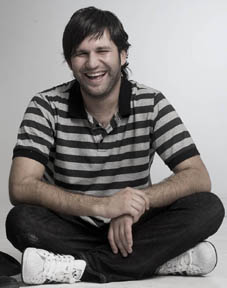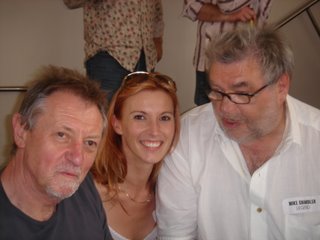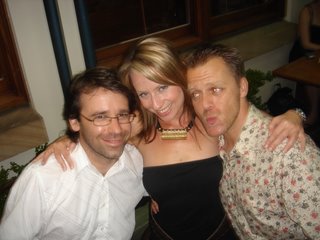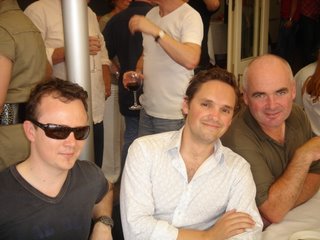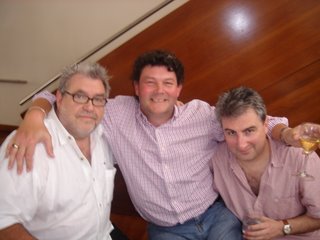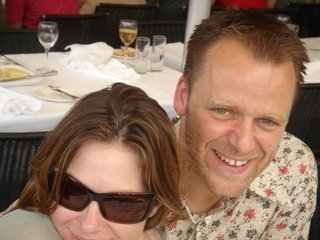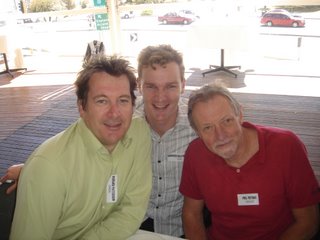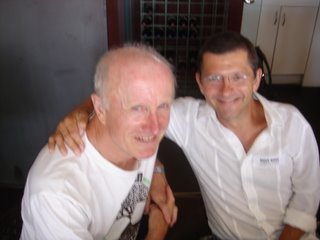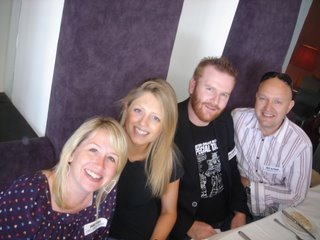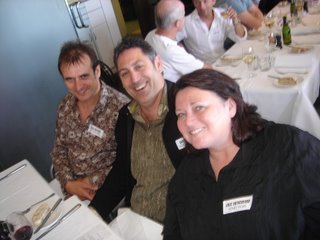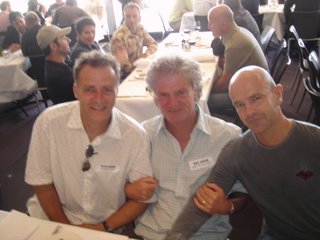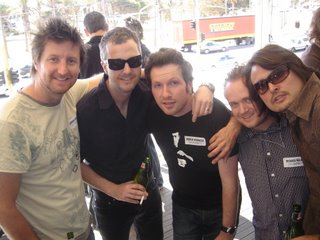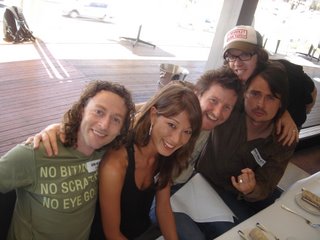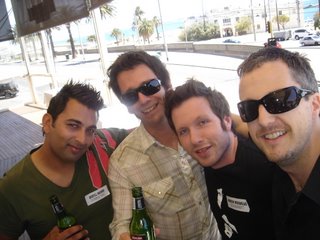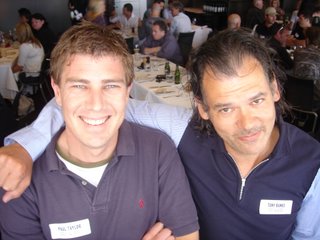



 The following is a letter from Julian Horton emailed to Lynchy recently (including pics of Julian and Fiona on safari), which was to form the basis of an upcoming 'Expats' article on his exploits and creative work in Africa. He also writes about his beloved safari vehicle which he named 'The Beast' and the dangers of driving in Kenya. The finished story will appear in the next issue of CB.
The following is a letter from Julian Horton emailed to Lynchy recently (including pics of Julian and Fiona on safari), which was to form the basis of an upcoming 'Expats' article on his exploits and creative work in Africa. He also writes about his beloved safari vehicle which he named 'The Beast' and the dangers of driving in Kenya. The finished story will appear in the next issue of CB.
I left Australia in June 2003 to take up a regional cd role with JWT, based in Bangkok. I soon came to realize what the term ‘based in’ meant and after two years of too much airline food and waking up wondering which city I was in, it was time to do something completely different.
And indeed, Africa is something else. In August 2005 I arrived in Nairobi, also known locally as Nairobbery. According to my Lonely Planet guide, it's the most dangerous city in Africa, having taken the title from Johannesburg a couple of years back. Now there's a number one to be proud of.
I work for The ScanGroup: Lowe, McCann, JWT and Grey all under one roof. Yes they’re part of different and competing international networks but hey, this is Africa.
The Group dominates the local industry, both creatively and in billings. You name it and there’s more than a 50% chance we handle it. It’s enough to make even Singo jealous.
There are probably only a handful of Aussie Creatives in Africa, and most of them work for ScanGroup. As well as myself there’s Pat Richer (ex Mojo Sydney), Justin Connolly (ex Clemenger Sydney) and Andrew White (ex ECD of O&M Singapore).
To make it even more incestuous I sit in an office that was once home to a good friend of mine - another Aussie, Damian Linklater.
Outside my 5th floor window eagles circle constantly in wide arcs, riding the currents. The smell of burning plastic wafts in with poisonous regularity. There is almost no garbage collection here, so most rubbish is burnt in backyards and by the side of the road, where it is often feasted upon by bloated-bellied goats.
In the office, people speak English, Swahili and a mixture called Sheng. I’m slowly learning Swahili, swear words first of course.
I’m also learning the meaning of 'Kenyan Time' in which people arrive for meetings seemingly at random. It’s not uncommon for clients to come to the agency an hour or two late for a meeting, or for friends to meet you an hour later than planned.
Things are generally a little ‘looser’ than Australia. From no booze buses (the government introduced them just before Christmas and they lasted 3 weeks) to the fact that television and radio commercials can be any length – if your edit works perfectly at 37 seconds then this is as just acceptable as 30.
Then there’s tribalism. People will often do what will benefit only their own tribe (there are 42 plus tribes in Kenya). Meaning you’ll look to employ a person from your tribe. Or in some cases like account management, a tribe that matches the tribe of the client. This doesn’t necessarily mean that they must be the same tribe – in some cases the account manager must be of a tribe that the client feels comfortable bossing around.
Another complication is skin colour. There are relatively few photographs on the Internet of Africans, so our Mac layouts for presentations tend to feature Europeans, leading to the occasional client asking in a somewhat embarrassed manner if they will, in fact, be African. But it’s not only photographic reference that can be a problem. One of my clients wanted to use mannequins for a promotion, but because they couldn’t find ‘African’ mannequins they ended up buying ‘white’ ones and painting them brown.
There is a myriad of belief systems that need to be taken into account when creating work for Africa. For instance, voodoo is common so it’s important to be careful when talking to less sophisticated markets. As an example, in the Congo, a character in your poster with an oversized nose may lead your audience to believe that drinking your brand of soft drink will give them a giant proboscis.
The Kenyan market, however, is quite sophisticated, and so are the clients, many of whom have studied overseas. Most of the world’s major brands are here, and some you may only recognize by their similarity to big brands: Kevian water, Kobil service stations, and the Silver Hound bus service.
What’s exciting is that most Kenyan clients actually believe in creativity. There is very little of the ‘paralysis by analysis’ that I encountered in Asia. Kenyans have a keen sense of humour and the majority of clients understand the value of being interesting and entertaining in order to communicate a message and a brand personality.
The most powerful medium is print. Newspapers are expensive, but the population devours them, mainly for the political news which is a topic of daily conversation. Because of the cost, ‘papers are generally shared. It’s estimated that on average every newspaper sold is read by more than ten people. It’s considered quite prestigious to have your own copy, and some people actually write their name on the front, as if they were books.
Radio is the other mass medium. The majority of the population don’t have electricity, much less television. People flock to the bars for the nightly television news at 7 because news, particularly of the political kind, is a national obsession. Corruption, political and otherwise, is always in the news.
And it’s a day to day reality. I visited an orphanage for HIV/Aids affected children, only to discover that almost all the client funding had been stolen by an intermediary. Instead of many thousands of dollars the orphanage received a couple of rolls of chicken wire, a bag of chook feed and some fertilizer.
Life outside the office has a certain edge to it too. I'm living on a property near the Ngong Hills, right near Karen Blixon's farm where Out Of Africa was set. I’m in the guest cottage of an amazing couple, Simon and Wiggy, who have been in Africa for 15 and 20 years respectively, doing extraordinary things like living with the pygmies in the Congo, or working as a cameraman in the midst of the bloodshed in Rwanda and Sudan. At the time of writing, Simon is building his own airplane.
With his guidance I’ve bought myself THE car. A custom built professional safari vehicle that took the likes of Onassis on Safari in its heyday. It's a huge, converted 1972 Landcruiser known simply as ‘The Beast’. Solid steel, built to go anywhere. Not only is it perfect for safari but I get a lot of leeway in the chaotic traffic around the city too.
In The Beast I’ve traveled widely in Kenya, mostly with Pat on camping adventures. I say adventure because the camp sites are not in any way partitioned off from the animals, and it’s not uncommon to hear a lion’s roar or be visited by buffalo or elephants in night. Some of the experiences I’ll treasure include seeing millions of flamingoes like distant pink candy floss as we approached Lake Nakuru, sitting on the roof of The Beast less than five metres from a tank-like white rhino, leaping onto the roof (dragging the esky of course) when a hippo* came to the camp site, seeing a cheetah chase down an Impala, getting head butted by a giraffe, being chased by a bull elephant that was sporting half an erection…the list goes on and on.
Safari aside, everyday life can be trying. Take the roads. They’re full of potholes, people drive like maniacs, and car jacking is a constant threat. Because of the latter there are frequent police checkpoints, with ‘fines’ able to be paid ‘on the spot’ without paperwork for real or imagined traffic infringements. Because I live way out of town, it’s also not uncommon to have to stop for crossing herds of cows and sheep. Then there’s driving at night with almost no street lights - statistically the chances of having an accident at night are 400 times as high as in Europe.
Poverty is endemic. Unemployment is around 60% and occasionally the frustration of the impoverished will flare up in violent incidents. Crime is expected, so security is everywhere. Everybody I know lives behind fences, either high and spiked or electrified, with security guards and dogs.
I used to jog a lot around Sydney harbour, a beautiful and relaxing experience. Here I jog near my home, along dirt roads and down bush tracks. Several months ago, another runner in the area was being stalked by a leopard as he ran. He was lucky, it wasn’t hungry. A few weeks later I saw a leopard myself as I drove along the same dirt road where I run, maybe 200 metres from my house. This can be a little unsettling, considering that leopards are lethal and strong enough to drag a zebra backwards up a tree to their lair.
I’ve become a better cd living here. And a tougher person. Overcoming obstacles is part and parcel of surviving. No electricity for weeks at a time. No water for days on end. I ‘irrigate’ my garden at night with the real possibility of leopards lurking in the trees. I’ve camped out in a flimsy tent in the wild, and woken up face to face with a huge monkey inside my house. Not to mention the office, where the obstacles to getting work done can be mind boggling.
Sitting in your first world office this probably all sounds so absurd as to be unbelievable. And there are moments where I have to check to make sure I’m not dreaming. But I certainly know I’m alive.
* Hippos, far from being the goofy, grinning ballet dancers that Walt Disney might have you believe, are bad tempered and aggressive - the biggest killers of humans in Africa.Kenya – a factual snapshotPopulation: 34 million
Official languages: Swahili and English.
Number of tribes: 42 +
Average life expectancy: 44 years








